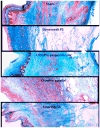Vaginal degeneration following implantation of synthetic mesh with increased stiffness
- PMID: 23240802
- PMCID: PMC3531826
- DOI: 10.1111/1471-0528.12085
Vaginal degeneration following implantation of synthetic mesh with increased stiffness
Abstract
Objective: To compare the impact of the prototype prolapse mesh Gynemesh PS with that of two new-generation lower stiffness meshes, UltraPro and SmartMesh, on vaginal morphology and structural composition.
Design: A mechanistic study employing a nonhuman primate model.
Setting: Magee-Womens Research Institute at the University of Pittsburgh.
Population: Parous rhesus macaques, with similar age, weight, parity and Pelvic Organ Prolapse-Questionnaire scores.
Methods: Following Institutional Animal Care Use Committee approval, 50 rhesus macaques were implanted with Gynemesh PS (n = 12), UltraPro with its blue line perpendicular to the longitudinal axis of vagina (n = 10), UltraPro with its blue line parallel to the longitudinal axis of vagina (n = 8) or SmartMesh (n = 8) via sacrocolpopexy following hysterectomy. Sham-operated animals (n = 12) served as controls.
Main outcome measures: The mesh-vagina complex was removed after 12 weeks and analysed for histomorphology, in situ cell apoptosis, total collagen, elastin, glycosaminoglycan content and total collagenase activity. Appropriate statistics and correlation analyses were performed accordingly.
Results: Relative to sham and the two lower stiffness meshes, Gynemesh PS had the greatest negative impact on vaginal histomorphology and composition. Compared with sham, implantation with Gynemesh PS caused substantial thinning of the smooth muscle layer (1557 ± 499 μm versus 866 ± 210 μm, P = 0.02), increased apoptosis particularly in the area of the mesh fibres (P = 0.01), decreased collagen and elastin content (20%, P = 0.03 and 43%, P = 0.02, respectively) and increased total collagenase activity (135%, P = 0.01). Glycosaminoglycan, a marker of tissue injury, was highest with Gynemesh PS compared with sham and other meshes (P = 0.01).
Conclusion: Mesh implantation with the stiffer mesh Gynemesh PS induced a maladaptive remodelling response consistent with vaginal degeneration.
© 2013 The Authors BJOG An International Journal of Obstetrics and Gynaecology © 2013 RCOG.
Conflict of interest statement
Figures



Similar articles
-
Impact of prolapse meshes on the metabolism of vaginal extracellular matrix in rhesus macaque.Am J Obstet Gynecol. 2015 Feb;212(2):174.e1-7. doi: 10.1016/j.ajog.2014.08.008. Epub 2014 Aug 12. Am J Obstet Gynecol. 2015. PMID: 25128444 Free PMC article.
-
Deterioration in biomechanical properties of the vagina following implantation of a high-stiffness prolapse mesh.BJOG. 2013 Jan;120(2):224-232. doi: 10.1111/1471-0528.12077. BJOG. 2013. PMID: 23240801 Free PMC article.
-
Impact of polypropylene prolapse mesh on vaginal smooth muscle in rhesus macaque.Am J Obstet Gynecol. 2019 Oct;221(4):330.e1-330.e9. doi: 10.1016/j.ajog.2019.05.008. Epub 2019 May 16. Am J Obstet Gynecol. 2019. PMID: 31102587 Free PMC article.
-
Surgical management of pelvic organ prolapse in women: a short version Cochrane review.Neurourol Urodyn. 2008;27(1):3-12. doi: 10.1002/nau.20542. Neurourol Urodyn. 2008. PMID: 18092333 Review.
-
[Development of better tolerated prosthetic materials: applications in gynecological surgery].J Gynecol Obstet Biol Reprod (Paris). 2002 Oct;31(6):527-40. J Gynecol Obstet Biol Reprod (Paris). 2002. PMID: 12407323 Review. French.
Cited by
-
Characterization of the T-cell response to polypropylene mesh in women with complications.Am J Obstet Gynecol. 2019 Feb;220(2):187.e1-187.e8. doi: 10.1016/j.ajog.2018.11.121. Epub 2018 Nov 9. Am J Obstet Gynecol. 2019. PMID: 30419195 Free PMC article.
-
Complications Reported to the Food and Drug Administration: A Cross-sectional Comparison of Urogynecologic Meshes.Female Pelvic Med Reconstr Surg. 2022 Jul 1;28(7):452-460. doi: 10.1097/SPV.0000000000001193. Epub 2022 Apr 28. Female Pelvic Med Reconstr Surg. 2022. PMID: 35536679 Free PMC article.
-
Mesh deformation: A mechanism underlying polypropylene prolapse mesh complications in vivo.Acta Biomater. 2022 Aug;148:323-335. doi: 10.1016/j.actbio.2022.05.051. Epub 2022 Jun 6. Acta Biomater. 2022. PMID: 35671876 Free PMC article.
-
A biomechanical analysis of different meshes for reconstructions of the pelvic floor in the porcine model.Arch Gynecol Obstet. 2022 Mar;305(3):641-649. doi: 10.1007/s00404-021-06344-9. Epub 2021 Nov 29. Arch Gynecol Obstet. 2022. PMID: 34845538 Free PMC article.
-
Emerging Nano/Micro-Structured Degradable Polymeric Meshes for Pelvic Floor Reconstruction.Nanomaterials (Basel). 2020 Jun 5;10(6):1120. doi: 10.3390/nano10061120. Nanomaterials (Basel). 2020. PMID: 32517067 Free PMC article. Review.
References
-
- Olsen AL, et al. Epidemiology of surgically managed pelvic organ prolapse and urinary incontinence. Obstet Gynecol. 1997;89(4):501–6. - PubMed
-
- Boyles SH, Weber AM, Meyn L. Procedures for pelvic organ prolapse in the United States, 1979–1997. Am J Obstet Gynecol. 2003;188(1):108–15. - PubMed
-
- Kenton K, Mueller ER. The global burden of female pelvic floor disorders. BJU Int. 2006;98(Suppl 1):1–5. discussion 6–7. - PubMed
-
- Subak LL, et al. Cost of pelvic organ prolapse surgery in the United States. Obstet Gynecol. 2001;98(4):646–51. - PubMed
Publication types
MeSH terms
Substances
Grants and funding
LinkOut - more resources
Full Text Sources
Other Literature Sources

